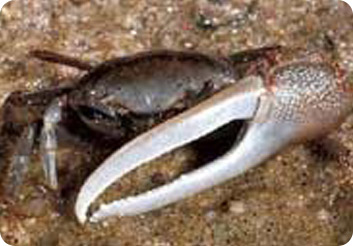The male fiddler crab may be a show-off, but he’s also a gentlemen. He gives his burrow to his mate, and he never picks on a female.
 Male fiddler crab. Credit: National Oceanic and Atmospheric Administration
Male fiddler crab. Credit: National Oceanic and Atmospheric AdministrationFiddlers are only an inch or two long. But they pack in close together, with thousands of them sharing the same territory in a mangrove forest or on a sandbar or mudflat. Each crab builds a burrow to protect itself against predators, and to provide a den for mating and incubating its eggs.
While females have two small claws for feeding, males have one feeding claw and one big claw. When a male repeatedly raises his little claw to his mouth, it looks like he’s pulling a bow over the big, fiddle-shaped claw -- hence the name “fiddler.”
He waves the big claw around to shoo away other males or to attract females. If he loses the claw, he grows another one. In some species, the new claw isn’t as strong or heavy as the original one, but it looks good enough to convince other crabs.
When it’s time to mate, the females wander around checking out the males -- who, being guys, do a lot of showing off. A female may briefly check out a male’s burrow, then leave. If she stays, they go underground to mate. The male emerges the next day and seals the burrow to keep mom and the babies safe. He then searches for a new burrow, sometimes taking one from another male -- but apparently, never from another female.
Mom emerges from the burrow a couple of weeks later, allowing her newly hatched babies to wash out with the tide. They return several weeks later -- ready to join the busy colony.

